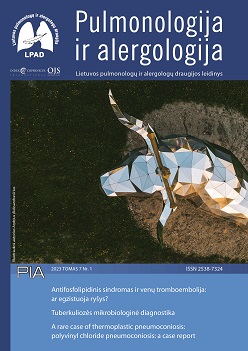DATA ANALYSIS OF PATIENTS WITH SEVERE COVID-19 WHO WERE TREATED WITH OXYGEN THERAPY THROUGH HIGH-FLOW NASAL CANNULAE IN HOSPITAL OF LITHUANIAN UNIVERSITY OF HEALTH SCIENCES KAUNAS CLINICS IN 2020–2022
Abstract
The aim of the study. To evaluate the demographic and clinical data and disease course of patients with severe coronavirus disease 2019 (COVID-19) receiving oxygen therapy via high-flow nasal cannula (HFNAC). Methods. A retrospective analysis was performed of data from 110 patients with severe COVID-19 who received oxygen therapy via HFNAC. Study participants were divided into two groups – successful treatment (the need for oxygen decreased or disappeared) and unsuccessful treatment (the patient was transferred to the intensive care unit, invasive lung ventilation was started, and/or died). Patient’s age, sex, body mass index, duration of oxygen therapy via HFNAC, patient’s comorbidities, C-reactive protein (CRB) concentration, leukocyte count, absolute neutrophil count, absolute lymphocyte count, the ratio of neutrophils to lymphocytes, prescribed treatment (antibiotics, Tocilizumab, Remdesivir, COVID-19 immune plasma), vaccination against COVID-19 data were evaluated. Results. One hundred ten patients were included in the study: successful treatment with oxygen therapy via HFNAC – 53 patients (31 males, 22 females), unsuccessful – 57 patients (35 males, 22 females). The age of the patients in the successful treatment group was significantly younger than that in the unsuccessful treatment group (p<0.05). Patients in the unsuccessful treatment group were significantly more likely to have more than two comorbidities, while patients in the successful treatment group were more likely to have up to two comorbidities (p<0.05). The patients of the unsuccessful treatment group had a significantly lower absolute number of lymphocytes and a higher ratio of neutrophils to lymphocytes compared to the patients of the successful treatment group (p<0.05). The risk of treatment failure increases in patients 57.5 years of age and older who are not prescribed tocilizumab treatment and in patients who have more than two comorbidities (p<0.05). Conclusion. Patients in the unsuccessful treatment group had a significantly lower absolute number of lymphocytes and a higher ratio of neutrophils to lymphocytes compared to patients in the successful treatment group. Age, the number of comorbidities and the administration of Tocilizumab influenced the treatment outcome of patients with severe COVID-19 using oxygen therapy via HFNAC.


